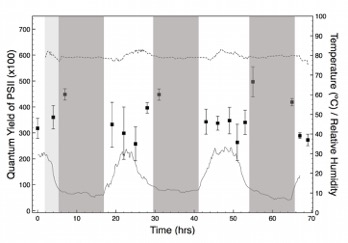2015 Annual Science Report
 SETI Institute
Reporting | JAN 2015 – DEC 2015
SETI Institute
Reporting | JAN 2015 – DEC 2015
Mars Analogs: Habitability and Biosignatures in the Atacama Deser
Project Summary
This project focuses on the study of habitability in the Atacama Desert of northern Chile, one of the driest regions on Earth. We want to understand how life adapts and survives in an environment where liquid water is exceedingly rare, and how biosignatures are preserved in that environment after microorganisms die. These studies can become a very useful guide for future robotic missions to Mars. This year we focused on microbial communities that inhabit the interior of salt nodules in evaporitic lake deposits. These are the only known active microbial comunities in the driest parts of the Atacama. We wanted to understand how these microbial communities survive in an environment that excludes every other form of life. We suspected that the salt communities use atmospheric water vapor as a source of water to run their metabolic processes. We showed that this is indeed the case with a combination of field and laboratory tools. Our results suggest that the salt substrate could be one of the last possible habitats for life in extremely dry environments.
Project Progress
The Atacama Desert of northern Chile is one of the driest regions on Earth, with areas that exclude all plants and animals and where soils have extremely low microbial biomass. However, in the driest parts of the desert there are microorganisms that colonize the interior of salt nodules in evaporitic lake deposits (Figure 1), where they are sustained by condensation of atmospheric water triggered by the salt substrate (aka deliquescence). Using a combination of in situ observations of variable chlorophyll fluorescence and controlled laboratory experiments, we investigated whether this endolithic community is capable of metabolic activity in the extreme dryness of the Atacama.
We focused our study on the photosynthetic activity of cyanobacteria found inside the salt nodules. Using a Pulse Amplitude Modulation (PAM) Chlorophyll Fluorometer we monitored in the field when and for how long the cyanobacteria were metabolically active, and how that activity changed with the natural daily cycles. We found that the cyanobacteria inside the nodules were active for periods of at least several days during and after wetting events (Figure 2). We complemented these measurements with laboratory analyses of carbon fixation in the presence of light, and oxygen respiration analyses under dark/light conditions. Together, our results demonstrate that photosynthetic cyanobacteria inside the nodules are a source of organic carbon to the whole community.

Overall, our results confirmed that metabolism occurs inside the salt substrate despite the extreme dryness of the Atacama. These results add to a growing body of evidence that as conditions become increasingly dry, living processes are restricted to specialized micro-niches. Ultimately, the capability to actively provide liquid water to the community, and to retain water after a moist event, likely make the salt nodules the ultimate substrates for survival under prolonged and extreme environmental dryness. We think that a similar survival strategy could have evolved on Mars as conditions became increasingly dry, if life ever evolved on the planet. Here, in addition to sourcing liquid water and providing shelter against UV, the salt substrate might also act as antifreeze, thereby expanding the range of conditions compatible with metabolic processes both in terms of water deficit and temperature. Future work will focus on that possibility.
Publications
-
Artieda, O., Davila, A., Wierzchos, J., Buhler, P., Rodríguez-Ochoa, R., Pueyo, J., & Ascaso, C. (2015). Surface evolution of salt-encrusted playas under extreme and continued dryness. Earth Surface Processes and Landforms, 40(14), 1939–1950. doi:10.1002/esp.3771
-
Davila, A. F., Hawes, I., Araya, J. G., Gelsinger, D. R., DiRuggiero, J., Ascaso, C., … Wierzchos, J. (2015). In situ metabolism in halite endolithic microbial communities of the hyperarid Atacama Desert. Frontiers in Microbiology, 6. doi:10.3389/fmicb.2015.01035
-
Wierzchos, J., DiRuggiero, J., Vítek, P., Artieda, O., Souza-Egipsy, V., Škaloud, P., … Ascaso, C. (2015). Adaptation strategies of endolithic chlorophototrophs to survive the hyperarid and extreme solar radiation environment of the Atacama Desert. Frontiers in Microbiology, 6. doi:10.3389/fmicb.2015.00934
-
PROJECT INVESTIGATORS:
-
PROJECT MEMBERS:
Octavio Artieda
Collaborator
Carmen Ascaso
Collaborator
Ian Hawe
Collaborator
Jacek Wierezchos
Collaborator
-
RELATED OBJECTIVES:
Objective 2.1
Mars exploration.
Objective 5.1
Environment-dependent, molecular evolution in microorganisms
Objective 5.3
Biochemical adaptation to extreme environments
Objective 6.1
Effects of environmental changes on microbial ecosystems
Objective 6.2
Adaptation and evolution of life beyond Earth
Objective 7.1
Biosignatures to be sought in Solar System materials
Objective 7.2
Biosignatures to be sought in nearby planetary systems

